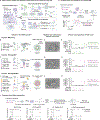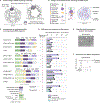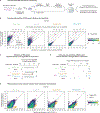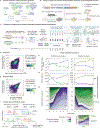Engineering RNA export for measurement and manipulation of living cells
- PMID: 37437570
- PMCID: PMC10528933
- DOI: 10.1016/j.cell.2023.06.013
Engineering RNA export for measurement and manipulation of living cells
Abstract
A system for programmable export of RNA molecules from living cells would enable both non-destructive monitoring of cell dynamics and engineering of cells capable of delivering executable RNA programs to other cells. We developed genetically encoded cellular RNA exporters, inspired by viruses, that efficiently package and secrete cargo RNA molecules from mammalian cells within protective nanoparticles. Exporting and sequencing RNA barcodes enabled non-destructive monitoring of cell population dynamics with clonal resolution. Further, by incorporating fusogens into the nanoparticles, we demonstrated the delivery, expression, and functional activity of exported mRNA in recipient cells. We term these systems COURIER (controlled output and uptake of RNA for interrogation, expression, and regulation). COURIER enables measurement of cell dynamics and establishes a foundation for hybrid cell and gene therapies based on cell-to-cell delivery of RNA.
Keywords: RNA; delivery; export; extracellular vesicles; monitoring; non-destructive; reporter; virus-like particles.
Copyright © 2023 The Authors. Published by Elsevier Inc. All rights reserved.
Conflict of interest statement
Declaration of interests Patent applications have been filed by the California Institute of Technology related to this work (US application numbers 17/820,232 and 17/820,235). M.B.E. is a scientific advisory board member or consultant at TeraCyte, Primordium, and Spatial Genomics.
Figures







Comment in
-
RNA "COURIERs": Enabling synthetic cell-to-cell communication in human cells.Cell. 2023 Aug 17;186(17):3526-3528. doi: 10.1016/j.cell.2023.07.030. Cell. 2023. PMID: 37595562
References
Publication types
MeSH terms
Substances
Grants and funding
LinkOut - more resources
Full Text Sources
Other Literature Sources
Research Materials

